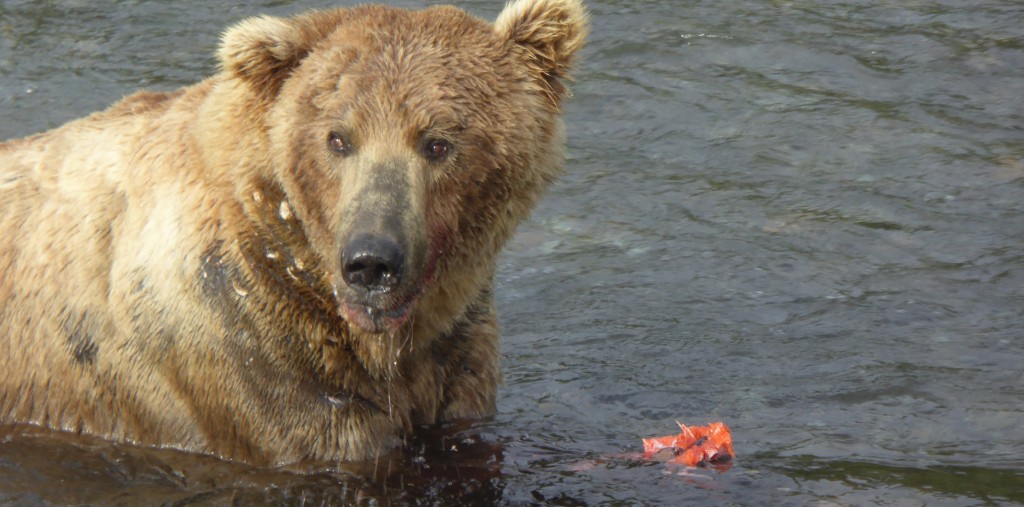By Mike Fitz
On June 30, 2018, I watched one of Brooks River’s largest bears, 747, catch and eat eighteen salmon in a little over three hours. Earlier in the day, bearcam viewers watched him catch and consume many others. Conservatively, his catch that day can be reasonably be estimated at 30 salmon. If each salmon weighed five pounds (2.3 kg) then 747 ate 150 pounds (68 kg) of fish in just one day. Is this normal though? How many salmon do they eat over an entire summer?
We often observe bears like 747 or 480 Otis partake in marathon fishing sessions at Brooks Falls. They sit for hours in the water, catching fish after fish after fish. During these moments, their hunger appears insatiable. Adult bears at Brooks Falls can catch and eat dozens of salmon per day when fishing conditions are optimal. While no study has tried to quantify a Brooks River bear’s annual salmon consumption, a study from Kodiak Island can offer some insight.
Kodiak bears, although currently considered a subspecies of brown bear (Ursus arctos middendorffi), are very closely related to bears on the Alaska Peninsula, including Katmai. Like all brown bears, they shed their fur once per year in early to mid summer. Since new fur grows during the bears’ active season, it contains a record of what the bears ate during that time. Studies of captive bears had previously determined the relationship between mercury intake and hair mercury content. To apply this to bears on Kodiak, researchers first determined how much mercury is found in the Pacific salmon that spawn on Kodiak. They then analyzed the mercury content found in the bears’ fur to gain an estimate of salmon consumption. Not surprisingly, the results indicate bears eat a lot of salmon.
Adult male bears on Kodiak ate the most salmon on average, consuming an incredible 6,146 pounds (2,788 kg) per bear per year! Adult females ate 3,007 pounds (1,364 kg). Salmon consumption varied among subadult bears, independent juvenile bears between 2.5 and 5.5 years old. Subadult females ate 1,248 pounds (566 kg) while subadult males ate 1,305 pounds (592 kg) of salmon per bear per year.
Bears at Brooks Falls don’t often eat 150 pounds of fish per day, like 747 demonstrated earlier this summer. A specific set of circumstances—very hungry bears, high densities of salmon at Brooks Falls, and little competition from other bears for the most productive fishing spots—must coincide to produce a consumption rate that high and most of the time the catch rate is less. Based on the results from Kodiak, however, Katmai’s bears will easily consume thousands of pounds of fish over the course of summer and fall. In Katmai as well as on Kodiak Island, salmon are the brown bears’ most important food.
Bears must eat a year’s worth of food in six months or less to survive. This drives their nearly insatiable urge to catch and eat vulnerable prey. The incredible number of salmon they will eat illustrates their profound hunger.



